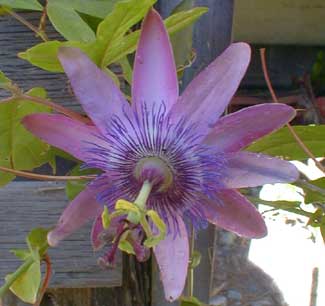
'Lavender Lady'
Amethyst Passionflower
"Oh, cut me reeds to blow upon,
Or gather me a star,
But leave the sultry passionflowers
Growing where they are."
-Grace Hazard Conkling
(1878-1958)
(1878-1958)
'Lavender Lady' has such remarkable violet-purple blooms it appears to be transluscent or nearly glow-in-the-dark. It is sometimes listed as synonymous with 'Amethyst,' but Passiflora amethystina is the true 'Amethyst,' which is not an actual species vine but is an an old English hybrid of P. kermesina with P. caerulea. 'Lavender Lady' was further hybridized by the American plant breeder Patrick Worley, & introduced in 1982. It was a back-crossed P. amethystina to the ultra-hardy P. caerulea rendering 'Lavender Lady' the passion vine of choice for more northerly gardens. So it is "an" amethyst passionflower, but it is not "the" 'Amethyst' passionflower.
Unfortunately the names 'Amethyst' & 'Lavender Lady' have been confused for many years so that what is sold in US nurseries as 'Lavender Lady' could sometimes be 'Amethyst.' They look so similar that one might never expect they actually had 'Amethyst' unless it unexpectedly dropped dead during a cold snap.
The original 'Amethyst' is a fertile plant that can produce orange fruits with a half-dozen or so small black seeds inside, & a tiny bit of edible pulp. 'Lavender Lady' is largely sterile, meaning it produces no pollen, but it will occasionally set fruit that is hollow or mostly hollow with only one small seed inside. So when you get a fruit you'll know certainly if it's really 'Lavender Lady' because it won't have much if any of the edible seeds & pulp inside a hollow maypop.
To add to the name confusion 'Lavender Lady' has also been confused for 'Star of Mikan' which was probably a seedling variant of 'Amethyst' & no longer marketed. Plus a recent color label has been generated for use by nurseries that gives the name parenthetically as 'Lilac Lady.' But 'Lilac Lady' passion vine actually a synonym for 'Tresederi' introduced in 1972 by Treseders Nursery, & it is a cross between P. caerulea & P. x violacea, with violacea designating hybrids of P. caerulea with P. racemosa & sometimes given the common name Mauve Passionvine.
The true 'Lavender Lady' will bloom just about year-round (with peaks in Spring & Autumn) if grown where winter temperatures don't fall below 35 degrees Fahrenheit, or if grown indoors or in a conservatory. But it is cold-hardy as a semi-evergreen or partial die-back vine where winters fall even as low as ten degrees, vs 'Amethyst' which could be at risk of dying at temperatures into the teens. On Puget Sound it begins flowering early summer & can continue until first frost, from July to September.
That the fruits or maypops are hollow is a speck unfortunate. Our regular Blue Crown Passionflower (P. caerulea) produces maypops galore with lots of sweet pulp inside. There'll be none of the pulp from 'Lavender Lady.' The skin of the maypops are edible for either vine, but have to be fried or otherwise cooked as one would with green tomatos, not being tasty raw.
The three-lobed leaves are evergreen or nearly so through winter. It's a vigorous climber easily achieving a sixteen to twenty foot spread. Thirty feet is not inconceivable in winterless conditions, but here on Puget Sound it is nowhere near as ultra-fast growing as regular P. caerulea.
See also the
Passion Flower Symbology Page